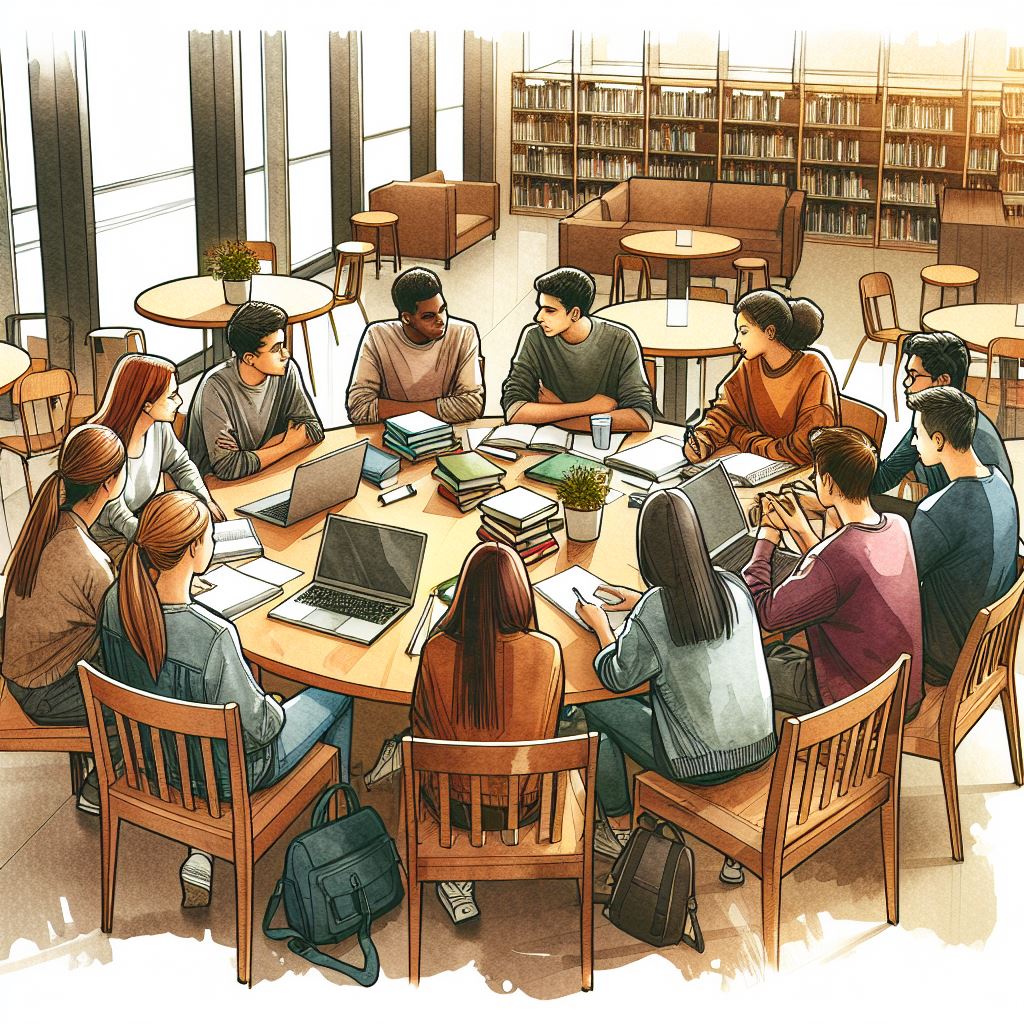
Fostering Effective Group Work in College Classes
By Kristin Ziska-Strange, Associate Director of Faculty Development & Instructional Design, TTS, Tufts University
Group work is a cornerstone of higher education. It encourages collaboration, improves communication, and helps students develop critical problem-solving skills which will be essential in their professional lives. Despite these benefits, many students dread group projects due to past negative experiences such as unequal participation, unclear expectations, or lack of support from instructors. As educators, we can structure group work in ways which maximize its potential while minimizing student frustrations. Here outlined are several practical strategies for structuring, and running group projects in college classrooms. We draw insights both from research and from experienced educators to enhance the group work experience for both students and faculty.
1. Define Group Structure and Roles
The structure of a group project is essential for its success. Group dynamics can quickly become chaotic without clearly defined roles, responsibilities, and expectations. Thoughtful structuring of the participant groupings and the work process not only set students up for success but also minimizes frustrations.
Action Item: Establish Specific Roles for Group Members
A key to successful group work is assigning or allowing students to choose specific roles within each team. The use of group roles such as “facilitator,” “timekeeper,” and “editor” provides role clarity, and ensures accountability and productivity. Defining and assigning these roles helps distribute responsibilities and encourages engagement from all group members. Rotating these roles over the timespan of the project allows students to cultivate different skills.
In addition, allowing your students some autonomy in selecting group members – who they can choose based on shared academic goals or work ethics – can foster smoother and more balanced collaboration.
2. Facilitate Effective Communication
One of the biggest barriers to successful group projects is poor or absent communication. Whether in-person or online, groups need clear channels to exchange ideas, make decisions, and resolve conflicts. Facilitating communication is crucial, especially in online and asynchronous class settings.
Action Item: Promote Structured Communication Methods
Articulating and prioritizing communication norms early on within the group is vital. You can encourage students to create group contracts which outline expectations for communication, including response times for emails or texts, meeting attendance, and responsibilities for absent members. For example, in a course I taught, groups set up shared Google Calendars to track deadlines and ensure transparency.
Providing students with tools like Canvas online discussion boards or shared Google Docs can also enhance communication. These tools allow for real-time collaboration and ensure that contributions are documented for the entire group to see. To reinforce these communication expectations and habits for the students, you can provide in-class activities which reinforce them early on in the project. For example, a week 1 team-building exercise or mock collaborative task can help students practice effective dialogue and problem-solving.
3. Encourage Individual Accountability
One of the most common student complaints about group work is the perception that some members contribute less than others. Ensuring individual accountability is critical to preventing these imbalances.
Action Item: Implement Peer Evaluation and Progress Check-ins
Incorporating peer evaluations can help keep students accountable for their individual contributions. When you have students regularly assess each other’s efforts and provide feedback this can help create an environment where everyone feels the need to contribute their fair share.
Additionally, regular progress check-ins keep students on task and allow you to monitor group dynamics. You can ask groups to report on their progress during class or through written updates. If problems arise, early interventions on your part can prevent larger issues down the line.
4. Leverage Technology Tools
In today’s educational landscape, technology plays a vital role in facilitating group projects, particularly for online or hybrid courses. The success of a project can hinge on use of collaborative tools, especially when students cannot meet in person.
Action Item: Use Technology to Streamline Collaboration
Tufts provides and supports a multitude of collaboration tools such as Canvas, Google Docs, and Zoom Whiteboards, which are excellent for managing group projects. Focus on tools such as discussion boards and shared documents which allow real-time collaboration and allow you to easily track student contributions.. These tools can also keep students accountable by tracking edits and updates, ensuring that all group members are contributing.
Encouraging students to use these tools not only helps them stay organized but also prepares them for the kinds of collaboration they will encounter in the workplace, where shared digital workspaces are increasingly the norm.
5. Prioritize Process Over Product
It’s tempting to focus solely on the final product of a group project, but research shows that real learning happens during the process. And for students who have not been successful in collaborative efforts previously, the journey is often more important than the destination. When you help students focus on the process you facilitate them engaging more deeply and working more collaboratively.
Action Item: Incorporate Process-Based Grading
Instead of only assessing the final deliverable, consider grading students on their group dynamics, communication, and collaboration skills. This might include designing reflective assignments, where students analyze both their own contributions and the group’s overall process. You can break larger projects into smaller tasks with mini-deadlines, which you then use to track student progress.
In-class activities you give your students, such as problem-solving tasks and collaborative discussions, allow them to practice these skills in real-time, reinforcing the idea that group work is about collective problem-solving.
6. Address Common Challenges: Conflict Resolution and Group Dynamics
Inevitably, group work will engender certain challenges. From scheduling conflicts to differences in work styles, these obstacles can derail a project if not handled well. Being proactive about teaching students how to navigate group dynamics is key to ensuring a positive experience.
Action Item: Teach Conflict Resolution Early
Many of our students never learn how to deal with interpersonal conflict. You can frame this as an opportunity to teach students how to resolve disagreements constructively. Early in the project, have students practice active listening, negotiation, and compromise. In addition, group contracts which outline dispute-handling can be a helpful tool to prevent issues from escalating.
Take care to remain vigilant about group dynamics. When you regularly check in on groups and offer constructive feedback you can nip issues in the bud. By asking probing questions about how groups are functioning, you can identify potential problems before they become unmanageable.
7. Provide Ongoing Feedback and Support
Group work is often one of the most challenging aspects of a course, but it can also be one of the most rewarding. By offering ongoing support, you can help your students improve their group work skills and navigate obstacles as they arise.
Action Item: Schedule Regular Feedback Sessions
Frequent feedback and reflection can help students improve their group dynamics and address challenges they face. Whether through mid-project evaluations, one-on-one meetings with you, or anonymous surveys, regular check-ins give students a chance to reflect on their progress and adjust their approach if necessary.
Additionally, providing feedback on both the group’s performance and individual contributions ensures that students remain engaged throughout the process and feel supported in their learning.
Conclusion: Empowering Students Through Structured Group Work
Group projects can be one of the most valuable experiences in a college classroom, but only if they are well-structured and supported appropriately. By clearly defining roles, facilitating communication, promoting accountability, and emphasizing the process over the product, you can create group projects which are engaging, equitable, and effective.
Ultimately, group work teaches students how to collaborate, problem-solve, and communicate—skills which will serve them long after they leave the classroom. By implementing these strategies, faculty can transform group projects from a dreaded task into a rewarding learning experience.
Looking for more Resources on Group Work? Check out a few of my favorites:
- Need some structure inspiration? Check out the Process Oriented Guided Inquiry Learning (POGIL) method.
- Looking for group role descriptions? Chris Drew at HelpfulProfessor.com has a list of twenty-one potential roles you can use.
- Oakley, Brent, Felder, & Elhajj have a guide to design and manage team assignments in college classrooms that can easily be adapted to online environments.
- UC Irvine has a wonderful example of a group contract you can use to create your own.
- Eberly Center at Carnegie Mellon University outlines various group work assessment methods and their advantages and disadvantages here:
- Want to check out an example of a group work rubric? Cornell has a fantastic example of one for you!
- You can have group discussions easily in Canvas. The Instructor Guide gives directions on how to make group-specific discussion boards.
- Google Docs is a great way to facilitate collaboration and provides benefits for you as the instructor. Check out Oakland University’s Weekly Teaching Tip highlighting group work in Google Docs.
- UNSW Sydney offers a table of several group reflection activities, many of which can be built easily in Canvas.
- Gathering feedback from your students can be enlightening. Chang & Brickman published their findings in “When Group Work Doesn’t Work: Insights from Students”.
- The Cult of Pedagogy Podcast Episode 215 “Seventeen Tweaks that Make a Big DIfference in Group Work”
- Teaching in Higher Ed Episode 403 “Demystifying Online Group Projects” with Rebecca Hogue.
SEE ALSO:
Group Work
Examples of Instructions for Students Working in Groups
Image credit: Illustration by Copilot from a prompt by TTS Staff



